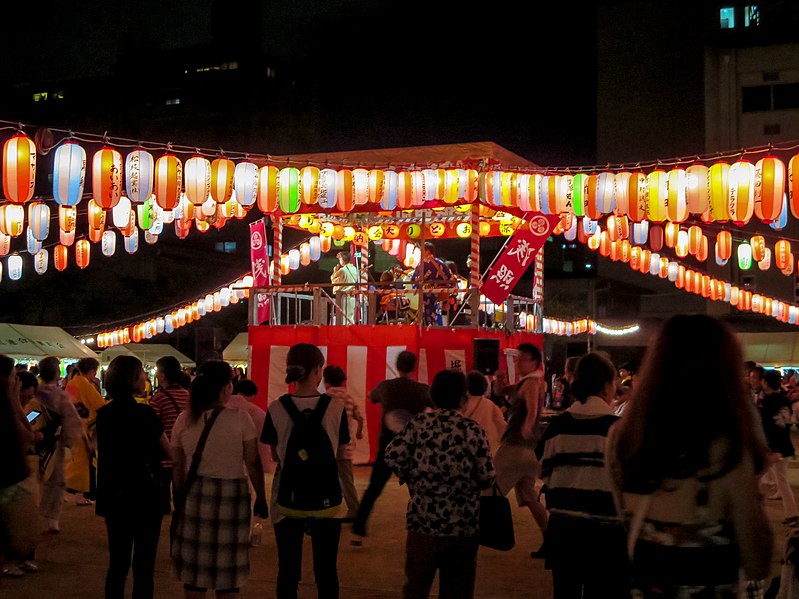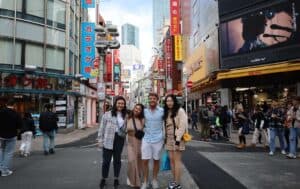Travelling in August in Japan offers a dynamic and culturally rich experience, marked by summer festivals, outdoor adventures, and unique seasonal offerings. As the heat of summer reaches its peak and the country celebrates the Obon festival (more on this below!), August is a time of both reverence and festivity. This guide provides essential tips to help you navigate the weather, participate in cultural events, and enjoy the seasonal highlights during your August trip to Japan.
Obon: Japan’s Spiritual Summer Celebration Held in August

August in Japan is marked by the Obon Festival, one of the most important and culturally significant events in the country. For tourists unfamiliar with this tradition, Obon offers a unique opportunity to witness and participate in a celebration that deeply resonates with Japanese spirituality and family values.
What is Obon?
Obon, also known as the Bon Festival, is a Buddhist tradition that honours the spirits of deceased ancestors. It is believed that during Obon, the spirits return to the world of the living to visit their families. The festival is a time for families to come together, pay respects to their ancestors, and ensure that their spirits are properly guided back to the afterlife.
Obon typically takes place over three days, usually around the middle of August (the exact dates can vary slightly depending on the region). It is a time of both solemnity and celebration, blending spiritual rituals with festive events.
Key Traditions and Rituals
- Mukaebi and Okuribi: The festival begins with mukaebi (welcoming fires) and ends with okuribi (farewell fires). These small fires are lit at the entrances of homes or on family altars to guide the spirits of ancestors back to the household at the start of Obon and then to send them off at the end of the festival. In some regions, especially in Kyoto, this culminates in large bonfires on mountainsides, like the famous Gozan no Okuribi (Daimonji) on August 16th.
- Bon Odori: One of the most recognisable features of Obon is Bon Odori, a traditional dance performed at festivals throughout Japan. The dance is typically performed in public spaces like parks or temple grounds, with participants dressed in yukata (summer kimonos). The style of the dance varies by region, but it is generally a communal and joyous event, meant to entertain the spirits of the ancestors.
- Visiting Graves: Families often visit the graves of their ancestors during Obon to clean the tombstones and offer flowers, incense, and food. This act of reverence is a way to show respect and gratitude to the departed and is a central aspect of the festival.
- Floating Lanterns: In many areas, the festival concludes with Toro Nagashi, a ceremony where paper lanterns are floated down rivers or into the sea. These lanterns symbolically guide the spirits back to the world of the dead, bringing the festival to a peaceful and reflective close. The sight of hundreds of glowing lanterns drifting on the water is both serene and visually stunning.
Experiencing Obon as a Tourist

For visitors to Japan, Obon provides a unique glimpse into Japanese culture and spirituality. Many public Bon Odori dances and Toro Nagashi ceremonies welcome participants and onlookers, making it possible to join in the festivities. Here are some ways to experience Obon during your August visit:
- Attend a Bon Odori: Many cities and towns host Bon Odori festivals during Obon. These events are often free and open to the public. Participating in the dance, even as a beginner, is a memorable way to connect with local traditions.
- Visit Kyoto for the Gozan no Okuribi: If you are in Kyoto during Obon, do not miss the Gozan no Okuribi on August 16th. The sight of the large bonfires on the surrounding mountains is one of the most iconic images of the festival.
- Observe Toro Nagashi: Cities like Tokyo, Kyoto, and Hiroshima often have Toro Nagashi events, where you can either watch or participate in the lantern floating ceremony. It’s a beautiful and reflective experience that captures the spirit of Obon.
- Explore Local Temples: Many temples hold special Obon ceremonies, where you can observe traditional rituals and perhaps learn more about the significance of the festival from the monks or local guides.
Respecting the Culture
While Obon is a time of celebration, it is also deeply rooted in spirituality and respect for ancestors. As a visitor, it is important to approach the festival with reverence and respect. Participating in Bon Odori, visiting graves, or attending a Toro Nagashi ceremony should be done with an understanding of its significance to the Japanese people.
August in Japan: Understanding the Weather

August is known for its intense summer heat, with high temperatures and humidity levels that can make the weather challenging for travellers. However, the regional variations across Japan offer opportunities to experience different climates depending on your destination.
Regional Weather Differences
- Hokkaido: Hokkaido, the northernmost island, remains a refuge from the extreme heat of other parts of Japan. With temperatures ranging from 18 to 27 degrees Celsius, Hokkaido offers a cooler and more comfortable climate, making it ideal for outdoor activities like hiking and sightseeing. August is also the season for lavender in Furano, adding a vibrant purple hue to the landscape.
- Tohoku: The Tohoku region in northeastern Honshu enjoys warm but tolerable temperatures between 22 and 30 degrees Celsius. The area’s natural beauty is at its peak, with lush green mountains and clear blue skies. August is also the time for the Nebuta Matsuri in Aomori, a spectacular festival featuring massive illuminated floats.
- Kanto: The Kanto region, including Tokyo, experiences hot and humid weather in August, with temperatures ranging from 25 to 33 degrees Celsius. The urban heat can be intense, so it’s important to stay hydrated and seek shade during the hottest parts of the day. The Sumida River Fireworks Festival, although occurring at the end of July, often spills over into early August with related events.
- Kansai: Kansai, home to cities like Osaka, Kyoto, and Nara, sees temperatures between 26 and 34 degrees Celsius. The humidity can be stifling, but this is also the season for the Gozan no Okuribi, a series of bonfires in Kyoto that mark the end of the Obon festival. The atmospheric fires on the mountains surrounding the city are a must-see.
- Chubu: The Chubu region, particularly the Japanese Alps, offers a cooler escape from the heat of the plains. Coastal areas like Nagoya are hot and humid (25 to 32 degrees Celsius), while mountainous regions provide cooler conditions ideal for trekking and nature walks.
- Chugoku: The Chugoku region, including Hiroshima, is warm and humid in August, with temperatures ranging from 25 to 33 degrees Celsius. Coastal areas can be particularly muggy, but the historical sites and beautiful scenery make it a worthwhile visit.
- Shikoku: Shikoku experiences similar weather, with hot and humid conditions and occasional rain showers. The Awa Odori Festival in Tokushima, held in mid-August, is one of Japan’s most famous dance festivals and draws huge crowds to the island.
- Kyushu: Kyushu is one of the hottest regions in Japan during August, with temperatures often reaching between 27 and 34 degrees Celsius. The high humidity, combined with the possibility of typhoons, makes it important to plan outdoor activities carefully. However, the island’s lush landscapes, particularly around Mount Aso, are particularly stunning in August.
- Okinawa: Okinawa’s subtropical climate brings warm temperatures ranging from 28 to 33 degrees Celsius. August is a perfect time to enjoy the island’s beautiful beaches and clear waters, ideal for diving and snorkelling. However, it’s also the peak of the typhoon season, so it’s wise to keep an eye on the weather forecasts.
August in Japan: Tips for Packing Appropriately

Packing for Japan in August requires careful consideration of the hot, humid conditions and the potential for sudden rain showers, especially in the southern regions.
- Light and Breathable Clothing: Choose lightweight and breathable fabrics such as cotton and linen. Loose-fitting attire will help keep you cool, and packing quick-drying clothing is a good idea in case you get caught in a sudden downpour.
- Sun Protection: Given the intense summer sun, it’s essential to pack sunblock, a wide-brimmed hat, and sunglasses. Lightweight long sleeves can also help protect your skin from the sun while keeping you cooler than bare skin exposed to the direct sunlight.
- Rain Gear: Even though August is generally drier than June and July, rain showers and the occasional typhoon can occur, particularly in southern Japan. A compact, sturdy umbrella and a lightweight, packable rain jacket will help you stay dry.
- Comfortable Footwear: Waterproof shoes or sandals are recommended, especially if you plan to visit coastal areas or engage in outdoor activities. Ensure your footwear is comfortable for long days of walking and exploring.
Japanese Festivals and Events in August

August is one of the most vibrant months in Japan, with many festivals taking place across the country. These festivals often combine traditional rituals with lively celebrations, offering visitors a deep dive into Japanese culture.
- Kyoto – Gozan no Okuribi (Daimonji): Held on August 16th, this is one of Kyoto’s most iconic events. Giant bonfires in the shape of kanji characters are lit on the mountains surrounding the city, symbolically guiding the spirits of ancestors back to the afterlife after the Obon festival.
- Tokushima – Awa Odori: Running from August 12th to 15th, Awa Odori is one of Japan’s largest dance festivals. Thousands of dancers in traditional costumes fill the streets, performing the distinctive and lively Awa dance.
- Aomori – Nebuta Matsuri: This early August festival features enormous illuminated floats parading through the streets of Aomori. The Nebuta Matsuri is a breathtaking display of art and light, accompanied by traditional music and energetic dancing.
- Nagasaki – Peace Lantern Floating: On August 9th, Nagasaki commemorates the victims of the atomic bombing with a poignant lantern floating ceremony. Thousands of paper lanterns are released into the river, creating a serene and reflective atmosphere.
Exploring Nature in Japan in August

While the heat of August can be intense, it’s also a time when Japan’s natural landscapes are at their most lush and vibrant. Many regions offer cooler retreats and stunning outdoor experiences.
- Mount Fuji: The official climbing season for Mount Fuji continues through August. Despite the heat, the summit can be quite cold, so layered clothing is recommended. August sees the most climbers, so it’s essential to book accommodation in advance if you plan to stay overnight.
- Kamikochi: This mountain valley in the Northern Alps remains a cool haven in the August heat. With its clear rivers, dense forests, and stunning mountain views, Kamikochi is ideal for hiking and nature walks.
- Daisetsuzan National Park: Located in Hokkaido, Daisetsuzan National Park offers some of Japan’s best hiking in August. The park’s alpine flora is in full bloom, and the cooler temperatures make it a perfect escape from the summer heat.
- Beaches: August is peak beach season in Japan, with warm waters and sunny skies making it perfect for swimming and water sports. Okinawa’s beaches, with their crystal-clear waters and vibrant coral reefs, are particularly popular.
August in Japan: Seasonal Foods

August is a time for light, refreshing dishes that help beat the summer heat. Japanese cuisine in August features an array of seasonal ingredients that are both delicious and cooling.
- Unagi (Eel): Unagi is a popular summer dish in Japan, believed to provide stamina and energy during the hot months. The rich, grilled eel served over rice is a must-try during your August visit, especially in regions known for their eel cuisine, such as Tokyo and Nagoya.
- Kakigori (Shaved Ice): This traditional Japanese dessert is perfect for cooling down in August. Made from finely shaved ice and topped with flavoured syrups and sometimes fresh fruit, kakigori is a favourite summer treat across the country.
- Seasonal Fruits: August is the peak season for watermelon and peaches in Japan. These fruits are often enjoyed as a refreshing snack or in desserts, providing a natural way to stay hydrated.
- Hiyashi Chuka: A popular summer dish, hiyashi chuka consists of cold ramen noodles topped with a variety of ingredients such as cucumber, ham, egg, and tomatoes. It’s a light, refreshing meal that’s perfect for hot August days.
August in Japan: Staying Healthy

The combination of high temperatures and humidity in August can present some health challenges, so it’s important to take steps to stay healthy and comfortable.
- Stay Hydrated: Always carry a water bottle and drink regularly. Japan’s vending machines and convenience stores offer a wide variety of drinks, including water, teas, and electrolyte beverages, which are essential for staying hydrated in the heat.
- Use Mosquito Repellent: Mosquitoes are prevalent in the summer, especially in rural or wooded areas. Packing mosquito repellent and wearing appropriate clothing can help prevent bites.
- Sun Protection: The August sun can be particularly strong, so apply sunscreen frequently and wear a hat and sunglasses. Taking breaks in shaded or air-conditioned areas will also help prevent heat exhaustion.
- Eat Light: Eating light, nutritious meals such as cold noodles, chilled tofu, and seasonal fruits will help keep your energy levels up without overwhelming your body in the heat.
Making the Most of Japan’s Summer Magic in August

Despite the heat, August is an exciting time to visit Japan, filled with cultural experiences, natural beauty, and seasonal delicacies. From the lively festivals to the serene mountains and beaches, there is something for every traveller. With the right preparation and an appreciation for the unique aspects of Japan in August, your trip is sure to be an unforgettable experience. Embrace the warmth, participate in the vibrant traditions, and savour the flavours that make August in Japan truly special.







